Basil is a vegetable crop belonging to the Lamiaceae family. Both types of the plant (green and purple) are widely used for medicinal and preventive purposes, as well as in cooking as a seasoning for meat dishes, sauces, marinades, desserts, and beverages. Residents of European countries, unlike those in Asia, prefer green varieties of the herb due to their milder taste and aroma.
Table of contents
What Green Basil Looks Like
The herbaceous plant has a branched form and grows as a bush with shoots about 50-70 cm tall. The leaves are oblong, with serrated edges, and covered with fine hairs. When flowering, a cluster or spike of white, light pink, or purple inflorescences (5-10 flowers) forms at the tips of the stems.
The taste of the herb is slightly salty and pungent. Breeders have developed many varieties with vanilla, mint, or lemon aromas.
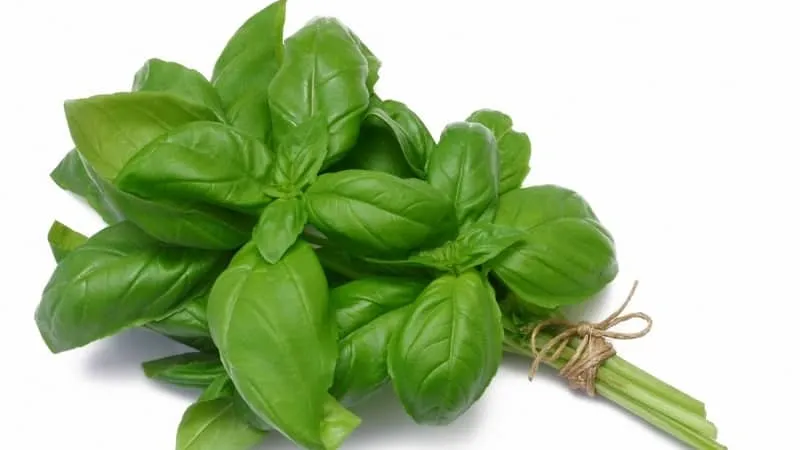
Chemical Composition and Caloric Value of Fresh Basil
100 g of the herb contains about 23 kcal. The carbohydrate content is 1.1 g, protein – 3.2 g, and fats – 0.64 g. The same portion includes:
- water – 92 g;
- dietary fiber – 1.6 g.
100 g of basil also contains:
- vitamin A – 264 mcg;
- vitamin K – 415 mcg;
- tocopherol – 0.8 mg;
- ascorbic acid – 18 mg;
- folic acid – 68 mcg;
- vitamin B1 – 0.03 mg;
- vitamin B2 – 0.1 mg;
- vitamin B5 – 0.21 mg;
- vitamin B6 – 0.16 mg;
- nicotinic acid – 0.9 mg.
The amounts of macro- and micronutrients are as follows:
- calcium – 178 mg;
- potassium – 295 mg;
- magnesium – 65 mg;
- phosphorus – 55 mg;
- iron – 3.18 mg;
- copper – 0.4 mg;
- selenium – 0.3 mcg;
- zinc – 0.8 mg.
The product also contains saturated (0.04 g) and polyunsaturated (0.4 g) fats, as well as numerous essential and non-essential amino acids.
Benefits and Harm of Green Basil
The beneficial components in the herb have a therapeutic effect on the body. It is an effective preventive and medicinal remedy.
Medicinal and Beneficial Properties
With regular consumption of green basil, positive changes occur in the body:
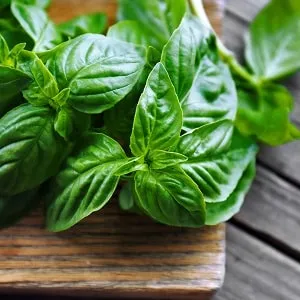 immune system strengthens;
immune system strengthens;- digestion and nutrient absorption improve;
- nervous system health enhances, increasing resilience to stress;
- sleep patterns normalize;
- mental performance stimulates;
- overall body tone improves.
Basil is beneficial for viral respiratory infections, as it helps:
- expel mucus;
- reduce high fever;
- alleviate symptoms.
The herb positively affects men's sexual health. It enhances potency and improves sexual life quality.
The wound-healing and anti-inflammatory properties of basil are used in treating oral mucosa conditions like stomatitis and tonsillitis. Fresh herbs not only heal ulcers but also effectively clean tooth enamel from plaque and prevent cavities.
Basil is recommended for people with cardiovascular issues due to its ability to cleanse blood vessels of cholesterol plaques. The essential oils in basil contain antioxidants that protect against tumors and slow aging.
Important! Basil is also indispensable for weight loss. The product is low in calories yet contains almost all necessary nutrients. It provides a feeling of fullness, and its fiber helps detoxify the body.
Contraindications
There are several restrictions to consider before consuming basil.
Contraindications include:
- epilepsy;
- recovery period after a heart attack or stroke;
- diabetes mellitus.
People taking blood-thinning medications (e.g., Warfarin, Xarelto) should avoid basil, as it promotes blood clotting.
Pregnant women should consume basil cautiously. Excessive amounts may increase uterine tone.
Note! Frequent medicinal use of fresh basil may harm tooth enamel.
Varieties of Fragrant Green Basil
The plant is popular among gardeners and is also grown indoors on windowsills.
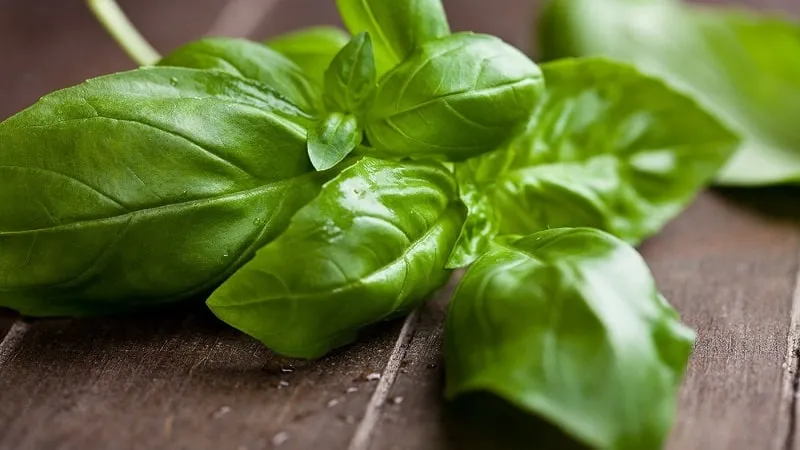
Preferred varieties include:
- Genovese. A compact bush (about 20 cm tall) with small smooth leaves and white flowers. It has a peppery-clove aroma, perfect for marinades and fresh salads. Ready for harvest one month after sprouting.
- Greek. Forms a spherical shape and grows up to 15 cm tall. Used in cooking and as a decorative plant. The taste is sweet and spicy, ideal for sauces, marinades, and salads. Leaves are ready two months after sprouting.
- Clove. Grows up to 60 cm with elongated bright green leaves and white flowers. Its distinct aroma complements meat dishes well. High-yielding, ready for harvest one month after sprouting.
- Gourmet. Features large leaves and grows up to 25 cm tall. Its pronounced flavor suits salads and main dishes. Can be dried, pickled, or frozen. Ready in 1.5 months.
- Caramel. Its caramel-fruity taste makes it ideal for desserts and beverages. Large, fleshy leaves are ready in one month. High yield – 3 kg per m².
- Bush. Forms many shoots with tender, aromatic leaves. Grown in pots or gardens, used in preserves and fresh dishes. Moderate yield (about 1.8 kg per m²).
- Thai Queen. A decorative variety with lush purple flower clusters resembling lilacs. Grown indoors or outdoors. Leaves are edible throughout the growing season.
How to Plant Green Basil
Basil is a heat-loving plant, so it's best grown from seedlings.
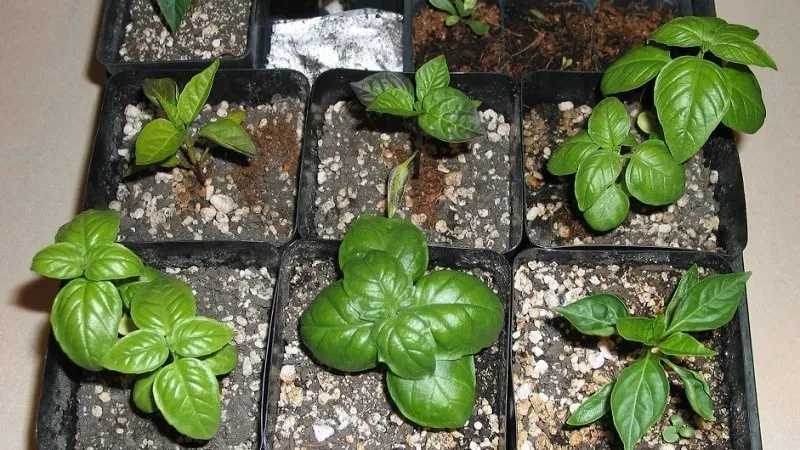
Sowing Seedlings
The optimal sowing time is late March. Seedlings are usually ready for transplanting 1.5 months after sprouting.
Prepare the soil mix as follows:
- Combine peat, compost, and sand in a 4:2:1 ratio.
- Steam the mixture for an hour to kill pathogens.
Alternatively, use store-bought potting soil, treated with a fungicide like Fongarid or Topsin.
Use containers about 7 cm deep, filling them nearly to the top.
Note! Seedling trays are also commonly used.
Sowing steps:
- Spread seeds evenly and cover lightly with soil (1 cm deep).
- Compact the soil gently and water carefully.
- Cover with plastic wrap and keep at +20°C or warmer.
- After germination (10-14 days), remove the cover and move to a cooler spot (+15…+19°C).
- Water regularly with lukewarm water.
Important! Overwatering may cause root rot.
After 2-3 leaves appear, transplant seedlings. Add ash (2 tbsp) and mineral fertilizer (1 tbsp) to 5 L of soil.
Make small holes, place seedlings without deep burying, and water as needed.
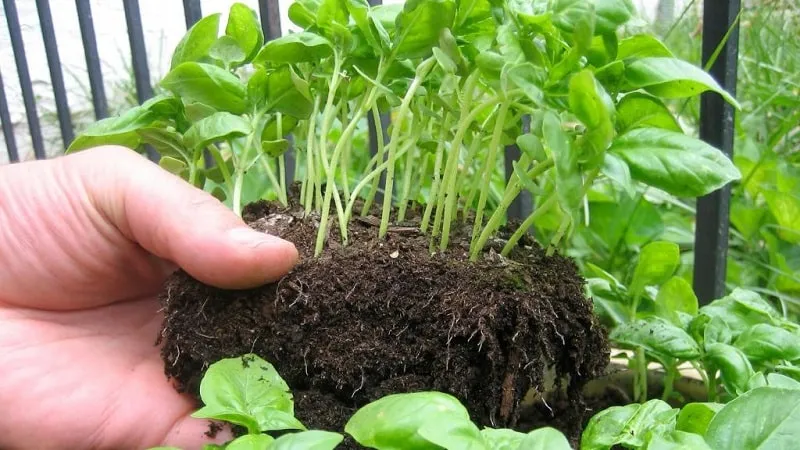
Planting in Open Ground
Transplant seedlings as follows:
- Space plants 20-25 cm apart, rows 35 cm apart.
- For staggered planting, keep 30 cm between plants.
Steps:
- Make furrows or holes.
- Water thoroughly with warm water.
- Transplant with soil intact.
- Cover with dry soil, leaving the central bud exposed.
- Compact the soil.
In central and southern Europe, basil can be sown directly. Sow in late April – May, depending on climate. Loosen soil, create 40 cm row spacing, and plant seeds 1.5 cm deep.
Thin seedlings after 2-3 leaves appear, keeping 20 cm between plants.
Conclusion
With proper planting and regular watering, basil can be harvested throughout the growing season. Pick the top shoots with a few leaves, as they are the most aromatic and nutritious. For preservation, cut whole stems to encourage new growth.







